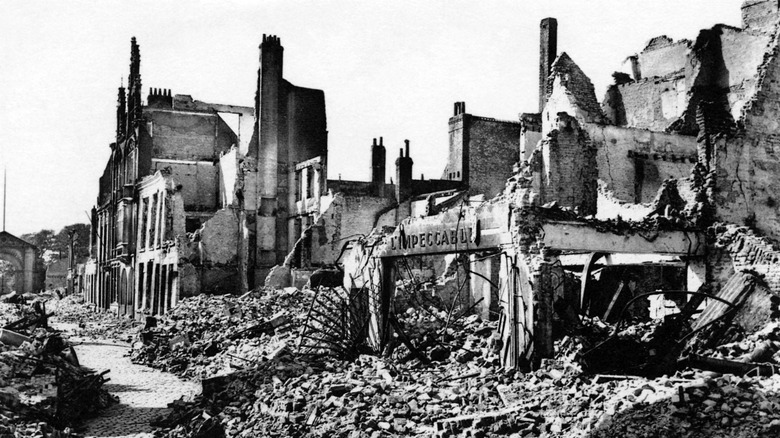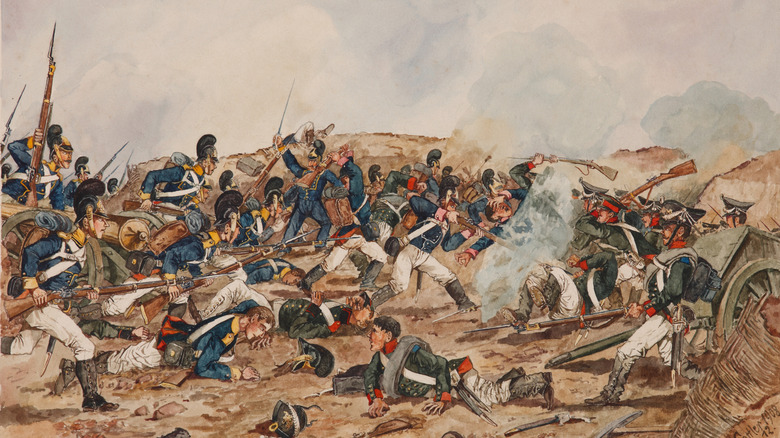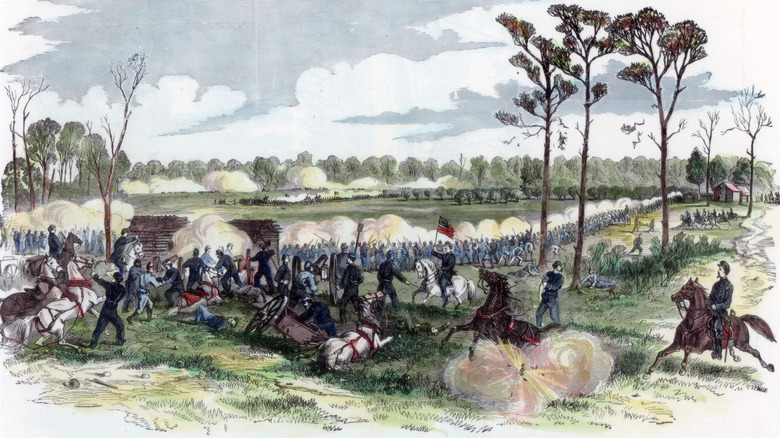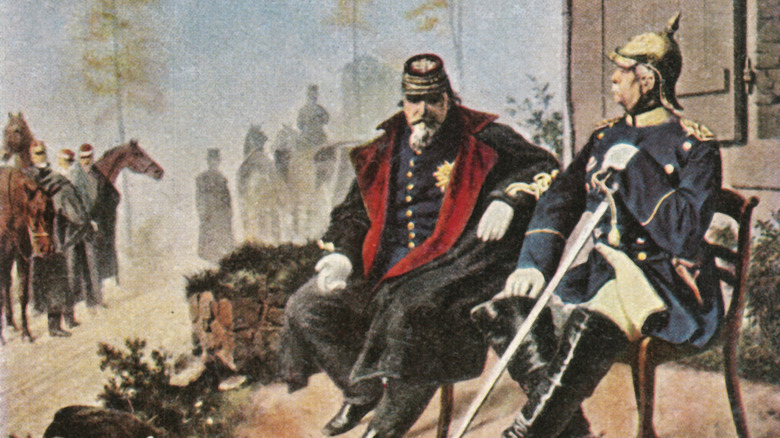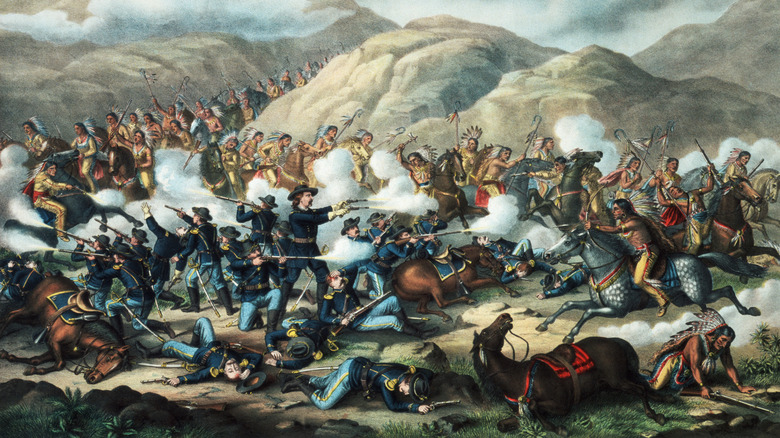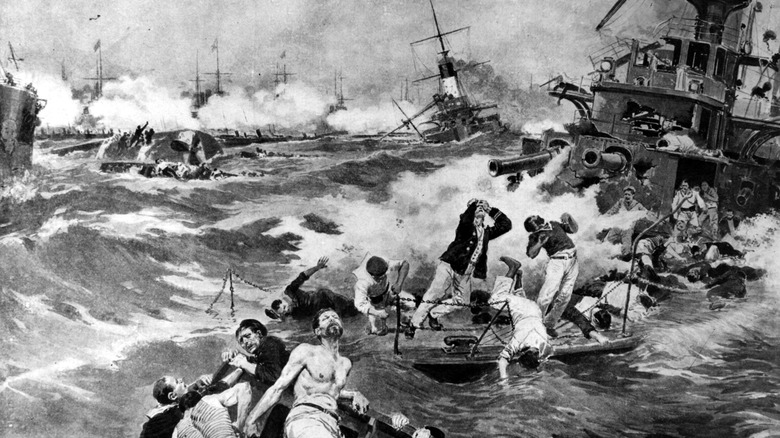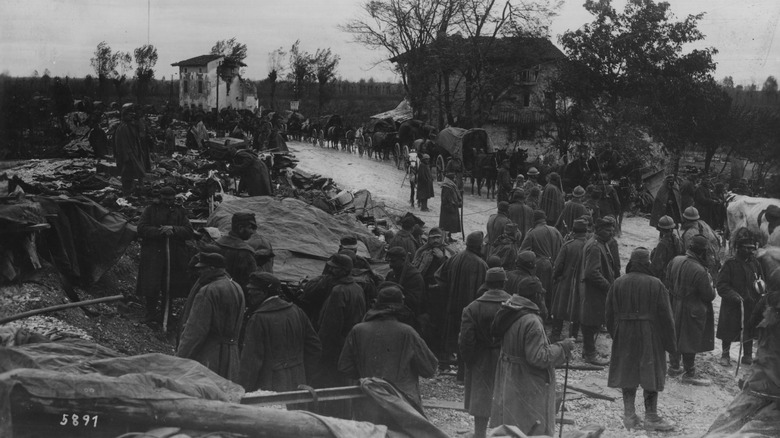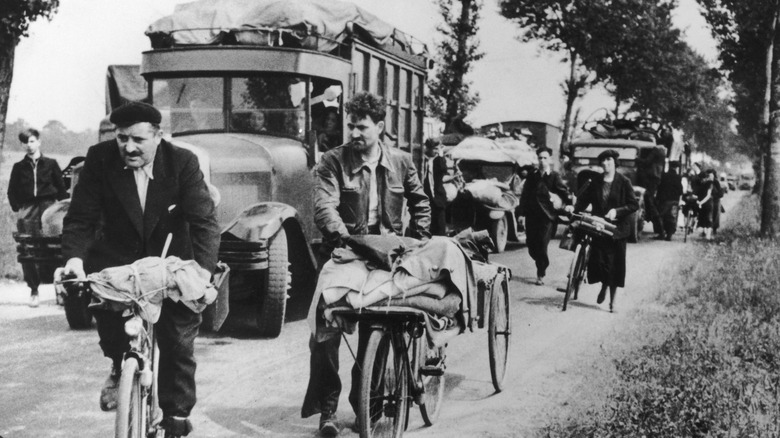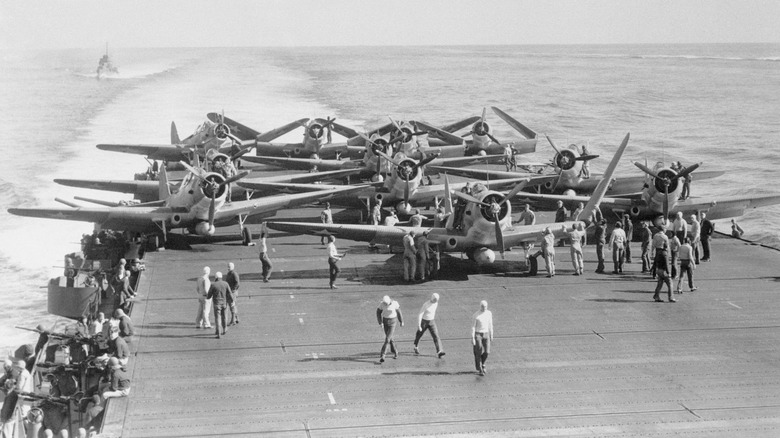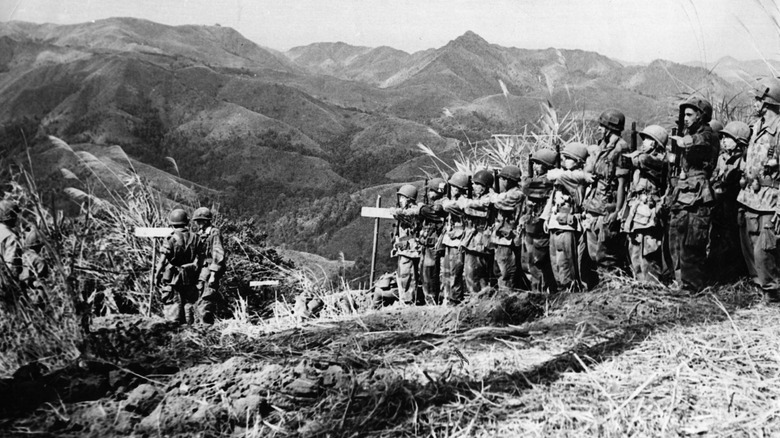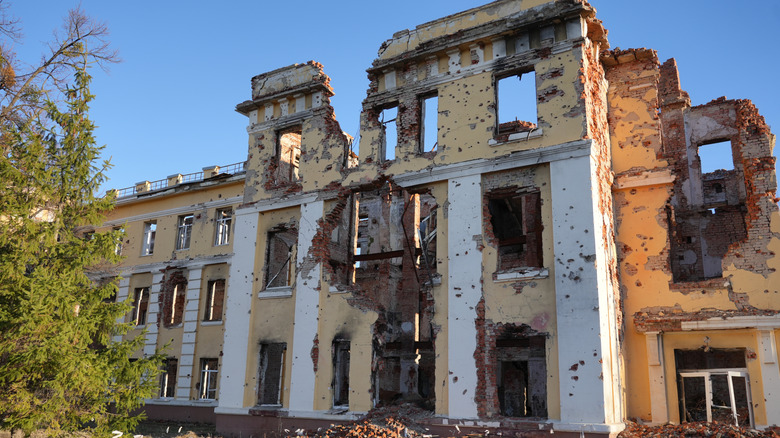The Most Devastating Military Defeats In Modern History
The past three centuries of human technological progress have, unfortunately, seen no apparent end to the human zeal for killing countless people in order to change the color of a territory on a map, hog resources, or enact generalized revenge. Every victory is someone else's defeat, and the names of battles that make one country's citizens puff up with pride also make their old enemies' cheeks burn with shame.
Some of the worst defeats and most crushing surrenders in military history have become shorthand for failure, with their names standing etched into the great ledger of human shortfalls. Others are known mostly only to the people of the beaten country, a sore spot in the national psyche that twinges in response to a name that other people may not even be able to pronounce. But one thing is certain: As long as war remains a human activity, someone will find a way to conduct it very, very ineptly.
Borodino (1812)
In fairness, Napoleon had more victories than defeats, but sometimes, it's the defeats that count. Overextended by invasions of effectively all of mainland Europe, he famously decided to take on the European land war final boss: Russia. His hope appears to have been to draw out the Russian field army, smash it into near-oblivion as he'd done with so many other armies, and then dictate a treaty to the helpless Russian state.
The Russians instead retreated all summer, drawing Napoleon deeper into the massive country. Finally, the tsar got annoyed, put General Mikhail Ilarionovich Kutuzov in charge of the armies, and told him to start shooting Frenchmen. Kutuzov chose to confront the invaders at a little town called Borodino, only 81 miles from Moscow. The resulting clash was a colossal bloodbath, and technically, the Russians lost, in that they took more dead and wounded and retreated from the field, leaving Moscow open to the French.
However, the Russians had done significant damage to the French army, killing dozens of commanders and injuring over 20,000 troops, in addition to the nearly 7,000 killed. Between these losses and the attrition of the small battles it had fought over the summer, Napoleon's Grande Armee was now incapable of the kind of agility and destruction French strategy required. This bleeding army would soon hit its high-water mark in Moscow before embarking on the famously devastating winter retreat, one of the most pathetic scenes of invasions that went horribly wrong in European military annals.
Shiloh (1862)
In early 1862, Ulysses S. Grant was not the overall commander of the Union war effort, instead working to advance along rivers and railroads into Confederate-held territory in Tennessee and Mississippi. The ultimate prize, of course, was control of the great Mississippi River itself, but damage to Confederate infrastructure and proving that a Union army could threaten internal Southern territory were also desirable outcomes.
To thwart Grant's thrust toward Mississippi, General Albert Johnston moved into southwestern Tennessee with his army to confront Grant at a minor port on the Tennessee River called Pittsburg Landing. It was a fiasco for the Southerners, and one of the most important battles of the Civil War. They fought ferociously on the first day of battle and pushed the Union forces back, but in the afternoon Johnston took a bullet to the leg that severed a vital artery, and he died of the hemorrhage. P.G.T. Beauregard was promoted to succeed him on the battlefield, and stopped the fighting since he thought the Confederatre forces had won. However, Beauregard was greatly mistaken.
In the morning, Beauregard and the men under him woke to a furious Union charge galvanized by reinforcements that had arrived in the night, while two Union ships appeared on the river and fired their artillery at the Confederate forces. Beauregard slunk away, and within a few weeks, the rail junction at Corinth, Mississippi, had fallen to the Union, giving Grant the space and infrastucture he needed to focus on recapturing the whole of the Mississippi. Johnston's death so grieved the president of the Confederate states, Jefferson Davis, that he later wrote that the leadership gap he left in the Confederate West sealed the rebel government's destruction.
Sedan (1870)
In 1870, France and a coalition of German states led by Prussia went to war with each other for a constellation of not-very-good reasons, including arguments over who should be the king of Spain, a nastily worded telegram, and a long dispute over where the border between France and Germany ought to be. France failed so badly in this war that their emperor got captured and Parisians spent the winter eating zoo animals.
The French army — what remained of it, at least, since the Prussian alliance had been slapping them away like houseflies — was trying to relieve a siege of the city of Metz. This army was burdened by the presence of Napoleon III, emperor of the French, who had to be kept safe (and would have been safe for the moment in, say, Paris.) Before they got there, German maneuvering forced them into the smaller fortress city of Sedan, which could not reasonably host or provision a large field army. The French forces tried to break out, but 400 German field guns hammered them into irrelevance, and the emperor of the French surrendered.
Napoleon was overthrown when word of his cature reached the capital, but the infant Third Republic's attempts to continue the war led to Paris being encircled by Prussian troops a mere 17 days after Sedan. The city surrendered after about four months. Among various other humiliations, the peace treaty saw the French provinces of Alsace and Lorraine snipped off and grafted onto the newly proclaimed German Empire, seeding a generational resentment that would contribute to the explosion of World War I.
Little Bighorn (1876)
After surveying parties found gold in the Native American-held Black Hills, the U.S. government decided to force the Lakota Sioux and their allies, the Northern Cheyenne and the Arapaho, onto reservations so that other people might get the gold out from under them. Lt. Col. George Armstrong Custer led one of the U.S. Army detachments that had the shameful assignment of forcing these Native American groups off their land.
Custer tried to sneak around the Lakota, who were encamped by the Little Bighorn River, in order to surprise them and sweep them toward another U.S. cavalry unit. The Lakota detected them, and when Custer's scout's reported that the Lakota were onto them, Custer decided to attack before the Native American force could retreat or disperse. Custer split his army into four, and here the exact timeline becomes murky: the Lakota pulverized one of the divisions sent after them and spent the night besieging the survivors after they regrouped with another unit. At some point in the day of fighting, the Lakota had also found and completely demolished Custer's command, killing them to a man: the only survivor that the remaining soldiers from other detachments found was an injured horse. (The horse survived.)
The Lakota alliance had won, but it was a temporary victory. The U.S. government sent much larger forces to enforce its will on the Native American populations of the northern plains, and within a year most of the tribes involved had been forced onto reservations, buying with their victory a mere few months of freedom.
Rorke's Drift (1879)
The Battle of Rorke's Drift is one of the real heartbreakers, a last-minute fumble of what was almost a crushing victory for a country fighting to escape colonial control. The forces of the Zulu Kingdom had just, as in earlier that day, completely obliterated a British column in the Battle of Isandlwana, killing 1,329 of 1,500 men. Riding high, 4,000 Zulu reinforcements disobeyed orders and advanced to besiege a tiny British fortification defending a crossing of the Buffalo River called Rorke's Drift.
The British lieutenant in charge, John Chard, had only 400 men, whom he hurriedly organized to prepare for a siege after being warned of the defeat at Isandlwana: The position at Rorke's Drift was adjacent to a Christian mission that held a hospital, and the 30 patients there could not be efficiently moved. The Africans reporting to Chard helped with the fortification but vamoosed when the Zulu approached, leaving him with 150 against a host of fearsome, confident Zulu warriors.
And yet, the British won. Six Zulu attempts to storm the position during ferocious night fighting were repulsed, leaving 500 Zulu dead, while only 15 of the defenders perished. Rorke's Drift passed into the records of British military glory, the British won their war against the Zulu, and in 1887, Zululand was annexed into the British Empire.
Tsushima (1905)
Tensions between Japan and Russia over which one of them got to bully China the most exploded into war in 1904, when Japanese destroyers blockaded a Russian fleet in Port Arthur in Chinese Manchuria. The Russians didn't have a particularly clear strategy for responding to the Japanese hostilities, and they lost battles on land and at sea as Japan moved against their forces in Manchuria and pressed up from Japanese-held Korea. Japan went on to take Port Arthur, in a costly but convincing victory that saw early wide-scale use of machine guns, and Russian hopes began to fasten on the redeployment of the Baltic Fleet, which even as the armies contended for Port Arthur was swinging around the globe to reinforce the Russian position in the east.
The Baltic redeployment almost began a second war when the over-excitable Russian commanders blew up some British fishing boats they had somehow mistaken for Japanese vessels. With apologies made and indemnities paid, the Russians' European navy crossed the globe in two big units, reuniting near Vietnam and steaming north to confront the Japanese in May 1905. The rickety Russian vessels were no match against the armaments of newly industrializing and militarizing Japan, and over a two-day battle near southern Korea, Japanese ships sank the majority of the world-crossing Russian fleet.
The Russian public was so incensed they revolted, forcing the tsar to accept a constitution. The delighted Japanese were now the power to beat in East Asia, a role they would maintain until their defeat two world wars later.
Caporetto (1917)
World War I had its share of climactic battles, but a lesser known one that very nearly knocked a member of the Allies out of the war occurred in 1917 at Caporetto, on the Italian Front. Austria-Hungary and Italy had been clawing at each other along the battlefront for over two years, both without reinforcement from their allies who were busy elsewhere. An Italian push in the 11th Battle of the Isonzo nearly caused the Austro-Hungarian forces to fold, forcing the Germans to send forces to prevent their collapse and hit back.
Austria had, as you might expect from an Alpine nation, forces trained to fight in the mountains. The Austro-German combined force stealthily built up supplies in the mountains near the modern Italian-Slovenian border, evading meager Italian surveillance by moving at night. When the trap was set, they sent a punishing fusillade of poison gas and conventional artillery, then charged down the hill. The Italian collapse was almost complete: 250,000 men were captured, half a million more lay dead or injured, or were missing, and hundreds of thousands more deserted. The Austro-German army captured the Italian headquarters at Undine and even menaced Venice.
This fiasco finally made the other Allies take the Italian front seriously, and they rushed reinforcements to staggering Italy. Almost exactly a year later, the Italians would have their revenge, shattering the armies of crumbling Austria-Hungary at Vittorio Veneto in a "reverse Caporetto."
Battle of France (1940)
When Germany overran France in the summer of 1940, the Nazi state notched one of the most startling conquests in European history. At a stroke, one of the key surviving Allies lay prostrate before an invader.
Germany would invade France along two fronts, south through quickly conquered Belgium and west through the Ardennes forest. (Italy, like a child allowed to help, made its own late and limited advances in Savoy.) The French had expected the main attack to come through Belgium, as it had in World War I, and so were unprepared for the multi-front battle, a shortcoming exacerbated by poor internal communications and the rapidity of the German advances. The Germans rebuilt bridges as fast as the retreating French could blow them up, and about six weeks after the invasion began, Paris was taken.
Per the truce that France and Germany inked, the northern half of France and Atlantic would be occupied by German forces; the south would be held by the nominally independent yet collaborationist Vichy government. The French war effort would have to be conducted via its vast network of colonies, its forces in exile, and through the bold spycraft and sabotage of the French resistance.
Midway (1942)
Midway Atoll, named for its position more or less halfway between San Francisco and Tokyo, was the site of a ferocious, tide-turning battle between U.S. and Japanese forces during World War II. Japan hoped that by striking this U.S. territory near Hawaii, it could force and win a battle with what remained of the US Pacific fleet after Pearl Harbor, neutering American seapower and neutralizing the biggest remaining threat to its plans for additional conquests.
American codebreakers had confirmed that Japan had its eyes on Miday in March 1942, so U.S. forces had some time to prepare before the Japanese fleet arrived in early June. Fighter aircraft from each force scrapped with each other and fired at enemy aircraft carriers, and over five gruesome days, the Americans gained the upper hand. Four Japanese aircraft carriers were sunk (avenging Pearl Harbor, in which they had all participated), compared with the loss of just one American carrier, while scores of Japanese aircraft, along with some of the best pilots in the Japanese air force, were eliminated.
For the rest of the war, Japan was on the back foot. Plans to advance against New Caledonia, Fiji, and Samoa were abandoned, and ultimately Japan never fully regained the initiative in the Pacific. Midway was, in fact, the beginning of the end.
Dien Bien Phu (1953-54)
Along with the other European powers that had lost holdings to the Japanese advance in World War II, France hoped to get its colonies back after the war, which was met with condescending chuckles and then shooting by the people living in these colonies. As part of its plan to keep control of Vietnam, France fortified an isolated valley called Dien Bien Phu, hoping to draw Viet Minh forces into a conventional battle and wallop them.
Staking the success of a war on an isolated valley outpost goes against all common sense, as the French soon discovered. They had thought that their superior weaponry and tech would allow them to bring tanks to bear while being resupplied by helicopter. Alas, the Viet Minh, who had taken the high ground, had taken heavy artillery with them — it was a schlep up the mountains, but they brought the weapons in pieces and reassembled them once they ascended — and destroyed the helicopter landing site. Meanwhile, monsoon rains — which were to be expected in Southeast Asia — muddied the roads beyond the tanks' capacities.
At the end of the battle, the French had suffered 2,293 fatalities, and over ten thousand men to Viet Minh captivity. Viet Minh casualties were also high, but they had knocked France out of the war; however, subsequent fighting among Vietnamese factions and, later, a mostly U.S. intervention force prolong the tragically awful Vietnam War for another 20 years.
Mosul (2014)
In June 2014, the jihadist Islamic State (IS) group launched a terrifyingly rapid invasion of northern Iraq, forming a statelike entity that controlled huge swathes of Iraq and Syria. One of the plum prizes that the Islamic State captured was the Iraqi city of Mosul. With American forces having largely withdrawn from the country, battered and war-weary Iraq was not in a strong position to resist them, and contemporary news reports wrote of soldiers changing into civilian clothes to blend in with the flood of refugees fleeing IS depredations. About 30,000 Iraqi troops broke before an IS force that may have numbered only 800 men.
Mosul was comfortably the largest and richest city in IS territory, with a population of 2 million in the metro area before its capture, complete with an industrial base, access to a nearby oil pipleline, and a transport network that included a large airport. Oh, and a well-stocked military base that IS immediately stripped. Controlling (and taxing) these assets was a huge boost to the finances and general wherewithal of the Islamic State. As a propaganda coup, it gave the group the credibility to announce a global caliphate and demand, if not actually obtain, the loyalty of the world's Muslims.
Kharkhiv (2022)
In 2022, when Russia, emboldened by the tepid Western reactions to its war in Georgia and seizure of Crimea, began its full-fledged invasion of Ukraine, Kharkiv was supposed to be an early and easy victory. The Soviet Union had lost two battles there in World War I, but independent Ukraine's second-largest city was a scant 31 miles from the border and largely Russian-speaking to boot. Kharkiv seemed primed to serve as an amuse-bouche for the conquest of Kyiv.
Instead, Putin's Russia repeated the failures of Stalin's Soviet Union. After the pressure on Kyiv was relieved in the early weeks of the war, Kharkiv was the site of Ukraine's next significant tactical victory, pushing Russian units away from the city and preventing its capture, if not its bombardment. The failure to capture Kharkiv was one of a series of Russian disappointments that allowed the survival of the Ukrainian state and government, converting the hoped-for rapid conquest into a years-long bloody quagmire that wrecked Russian credibility as a serious military power. When you need reinforcements from North Korea, you know you've done badly.
